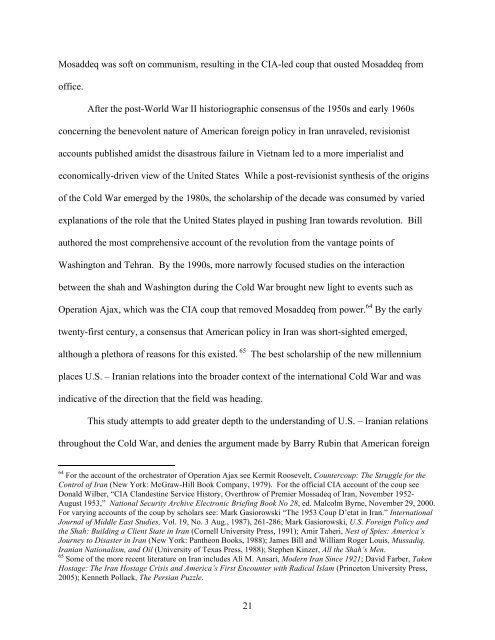AN AUGURY OF REVOLUTION: THE IRANIAN STUDENT ...
AN AUGURY OF REVOLUTION: THE IRANIAN STUDENT ...
AN AUGURY OF REVOLUTION: THE IRANIAN STUDENT ...
Create successful ePaper yourself
Turn your PDF publications into a flip-book with our unique Google optimized e-Paper software.
Mosaddeq was soft on communism, resulting in the CIA-led coup that ousted Mosaddeq from<br />
office.<br />
After the post-World War II historiographic consensus of the 1950s and early 1960s<br />
concerning the benevolent nature of American foreign policy in Iran unraveled, revisionist<br />
accounts published amidst the disastrous failure in Vietnam led to a more imperialist and<br />
economically-driven view of the United States While a post-revisionist synthesis of the origins<br />
of the Cold War emerged by the 1980s, the scholarship of the decade was consumed by varied<br />
explanations of the role that the United States played in pushing Iran towards revolution. Bill<br />
authored the most comprehensive account of the revolution from the vantage points of<br />
Washington and Tehran. By the 1990s, more narrowly focused studies on the interaction<br />
between the shah and Washington during the Cold War brought new light to events such as<br />
Operation Ajax, which was the CIA coup that removed Mosaddeq from power. 64 By the early<br />
twenty-first century, a consensus that American policy in Iran was short-sighted emerged,<br />
although a plethora of reasons for this existed. 65<br />
The best scholarship of the new millennium<br />
places U.S. – Iranian relations into the broader context of the international Cold War and was<br />
indicative of the direction that the field was heading.<br />
This study attempts to add greater depth to the understanding of U.S. – Iranian relations<br />
throughout the Cold War, and denies the argument made by Barry Rubin that American foreign<br />
64 For the account of the orchestrator of Operation Ajax see Kermit Roosevelt, Countercoup: The Struggle for the<br />
Control of Iran (New York: McGraw-Hill Book Company, 1979). For the official CIA account of the coup see<br />
Donald Wilber, “CIA Clandestine Service History, Overthrow of Premier Mossadeq of Iran, November 1952-<br />
August 1953,” National Security Archive Electronic Briefing Book No 28, ed. Malcolm Byrne, November 29, 2000.<br />
For varying accounts of the coup by scholars see: Mark Gasiorowski “The 1953 Coup D’etat in Iran.” International<br />
Journal of Middle East Studies, Vol. 19, No. 3 Aug., 1987), 261-286; Mark Gasiorowski, U.S. Foreign Policy and<br />
the Shah: Building a Client State in Iran (Cornell University Press, 1991); Amir Taheri, Nest of Spies: America’s<br />
Journey to Disaster in Iran (New York: Pantheon Books, 1988); James Bill and William Roger Louis, Mussadiq,<br />
Iranian Nationalism, and Oil (University of Texas Press, 1988); Stephen Kinzer, All the Shah’s Men.<br />
65 Some of the more recent literature on Iran includes Ali M. Ansari, Modern Iran Since 1921; David Farber, Taken<br />
Hostage: The Iran Hostage Crisis and America’s First Encounter with Radical Islam (Princeton University Press,<br />
2005); Kenneth Pollack, The Persian Puzzle.<br />
21















